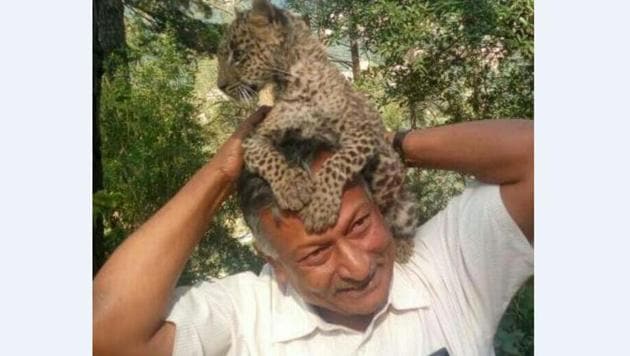Wildbuzz: The lovable bandit
Veteran hunter of man-eating leopards and tigers, Parwanoo-based Ashish Dasgupta, can tell from the blood trail of a wounded big cat where the bullet has struck home.
Veteran hunter of man-eating leopards and tigers, Parwanoo-based Ashish Dasgupta, can tell from the blood trail of a wounded big cat where the bullet has struck home. A blackish, coagulated blood trail augurs a stomach wound while lipstick pink, ‘lassi-like’ frothy blood implies the rifle slug pierced the lungs. Only a flesh/muscle wound spews the ‘normal red’ blood.

A long-standing member of the Himachal Pradesh Wildlife Advisory Board and honorary wildlife warden for that state, Dasgupta was consulted on the ballistics of the rifle used by unknown poachers to kill a female leopard on Tuesday in Hoshiarpur’s Shahpur village. He conclusively refuted the opinion of Punjab wildlife department officers that a small-calibre .22 rifle had been fired. Instead, Dasgupta cited use of a .30 calibre rifle and that assessment was consistent with the gaping dimensions of the bullet’s entry and exit holes.
Dasgupta has been a member of expeditions that have brought down 50 man-eating leopards and seven tigers across India. He has tracked maneaters on foot, including wounded ones, but his steely heart melted during the course of a Kinnaur tour. He was in the high mountains to probe the poaching of a female leopard.
“Forest officers showed me the dead female while Kinnaur villagers told me that a ‘chhe-chhe’ sound kept coming from jungles. I examined the leopard’s inflated teats and realised she had littered and had left behind a cub, which was crying for help. It took me two days to locate the male cub but instant love and a protective feeling overwhelmed me. His fearlessness and naughty playfulness led me to christen him, ‘Bandit’. I brought him up, took him for walks at Parwanoo and handed him over to the Rescue and Rehabilitation Centre at Tutikandi in Shimla, where he has settled down. Bandit promises to blossom into a handsome fellow studded with startling rosettes. His mother’s spirit rekindles in him,” Dasgupta told this writer.
Prisoner of love
The Indian Grey hornbill is a charismatic avian commonly observed paragliding between tall trees straddling the avenues while emitting a peculiar, squealing cry. This species is bestowed with the titular title of Chandigarh’s State Bird. In nature’s roll of honour, hornbills tilt towards monogamy and the male is unsurpassed when it comes to ‘patni sewa.’ In late spring, hornbill couples commence the build up to nesting in tree hollows. The female will erect a self-imposed barricade in the hollow with faecal matter, soil and mud pellets, leaving a slit for the male to deliver food. Once entrenched in the hollow, the female leaves herself entirely to the male’s mercy.

Since 2004, wildlife photographer Vinod Goel has spent many happy hours on breeding hornbills. “During courtship, a male is seen chasing a female and gifting her bark of a tree, petals of flowers or fruits to please her. They are in their own world and least bothered about anything else. The female was preening and loving the male as if she knew that on that day she would enter the cavity and remain there for more than two months. To me it appeared, on one occasion, as if she was kissing the eyes of the male. Both of them were trying to spend as much time together and then the female starts making efforts to enter the tree cavity. The male was watching her and helping her sometimes. Slowly, slowly the female entered the cavity as her tail outside shrunk continuously until it disappeared. The male made sure that his mate was comfortable and peeped inside to reassure himself. He brought a mulberry fruit to offer her as if to celebrate a big occasion in their life cycle,” wrote Goel.
Just how hard the male works can be gauged from a study conducted by E Santhoshkumar and P Balasubramanian. “During the 720 hours spent at 10 hornbill nests to monitor nesting behaviour over two breeding seasons, males visited nests 1,015 times to feed inmates, at an average of 17 times per day, and 13,680 food items were delivered,” the study revealed.
Surely, hornbills are a marriage made in heaven and worthy of poetic rapture! As hornbill field researcher, Ajay Gadikar, wryly remarked: “The female trusts the male blindly and the male does not commit breach of trust! A lesson to mankind!”
Moved by the above glowing accounts, some readers may wish to bestow ‘Pati Vishisht Sewa Medal’ on the male hornbill. However, wayward human hubbies may not relish wide publicity to such love stories.
vjswild1@gmail.com



